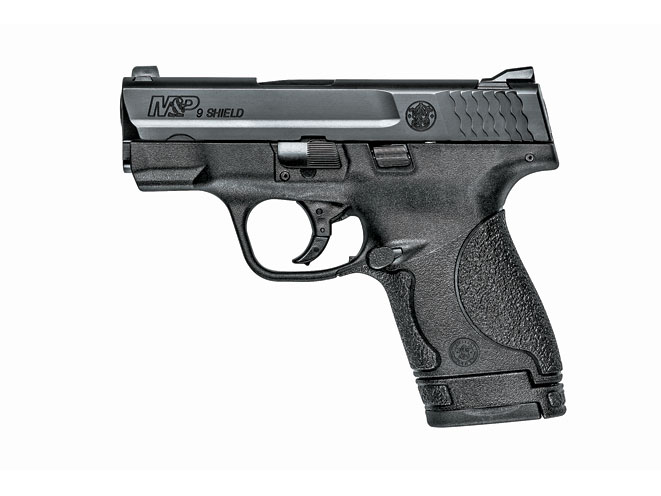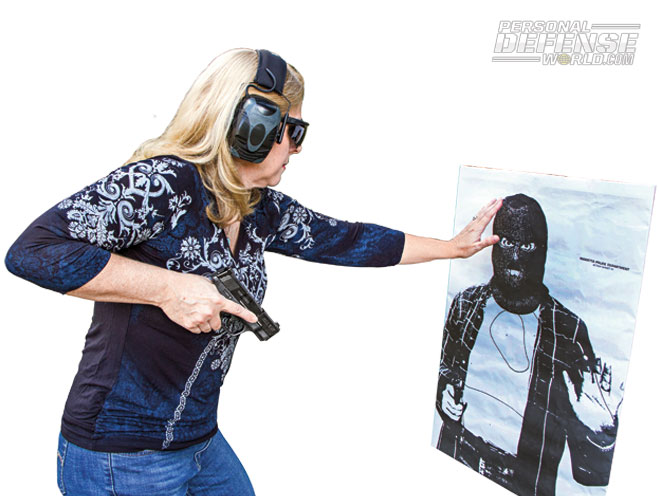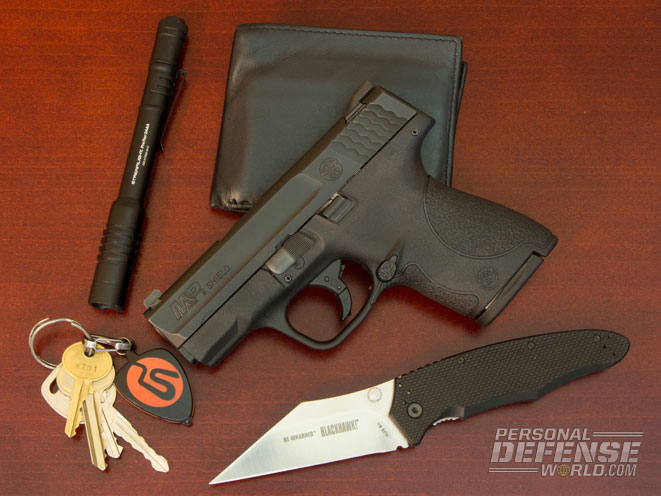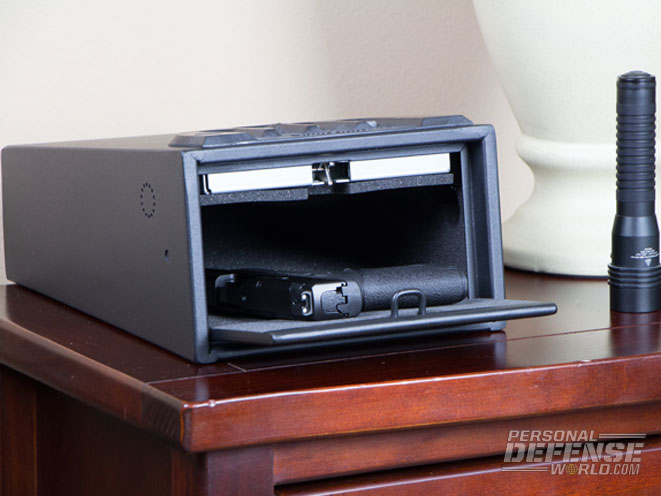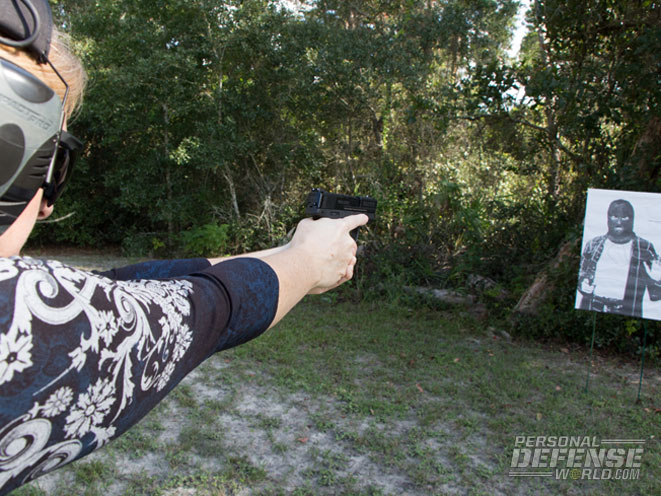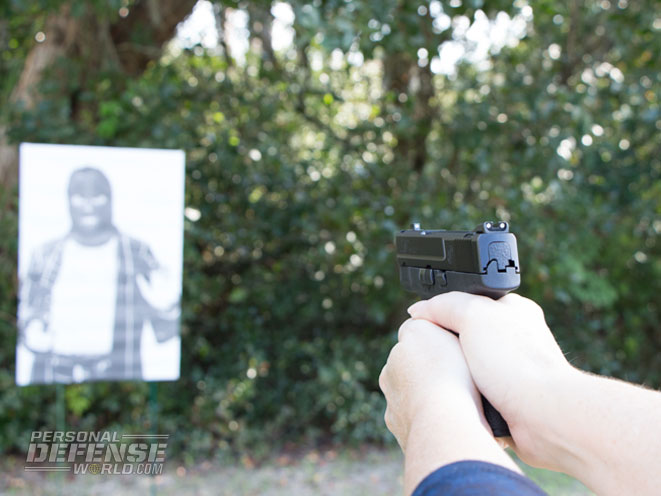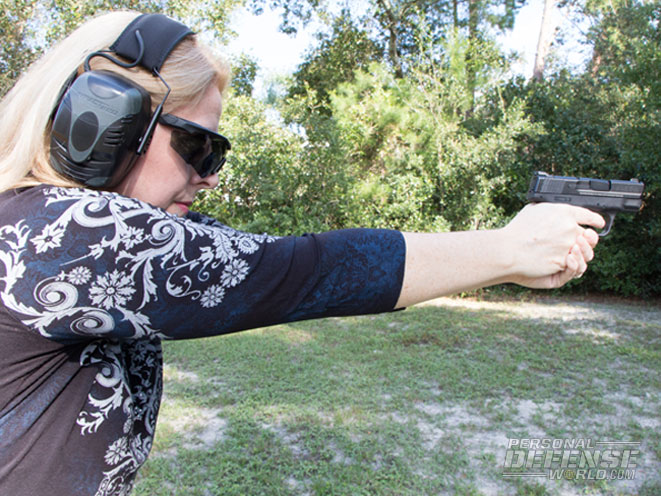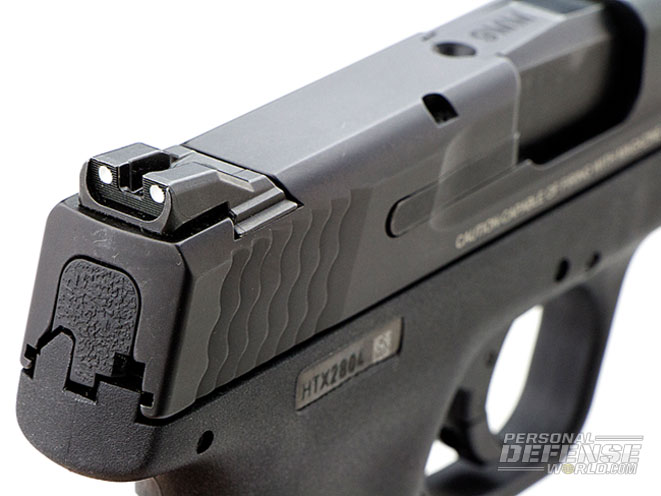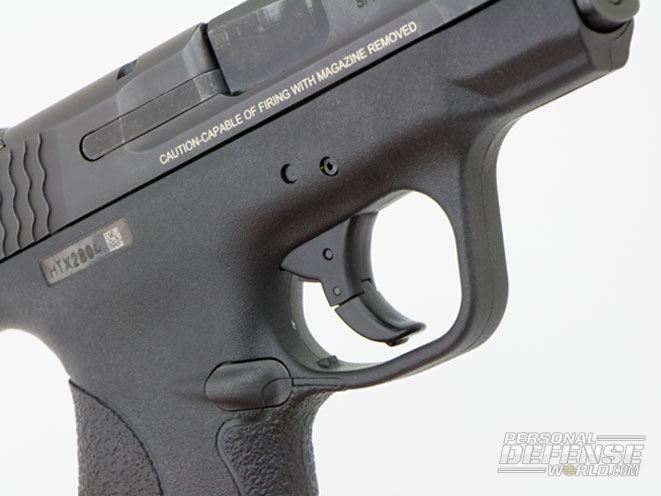It’s not often that removing a feature will sell more of a product, but that may just be the case with the newest Smith & Wesson M&P Shield pistol. Although it looks very similar to the original, S&W “fixed” the one objection many people had by removing the manual thumb safety.
Manual thumb safeties on pistols are, and have always been, a topic of debate among shooters. Some people like them, while others hate them. Often it seems there is no middle ground. When Smith & Wesson introduced the M&P Shield with a thumb safety in 2012, shooters seemingly polarized into two camps: those who would be happy to own the gun with the safety and those who would never buy the gun because of the safety. Fortunately for Smith & Wesson, the number of people willing to buy the gun was large enough to make the guns leap off of dealer shelves. The company was not deaf to the consumer demands for a safety-less version of the compact hangun, however, and has recently introduced just such a pistol.
When rumors of a new M&P Shield began to circulate, I was concerned that the pistol may ship with a simple plug where the hole for the safety would go on the original version of the gun. Once the new M&P Shield was announced, I was pleased to see that this was not the case. There are no holes, plugs or blemishes on the frame where a safety would go on another platform variant.
Advertisement — Continue Reading Below
Ultra-Slim Design
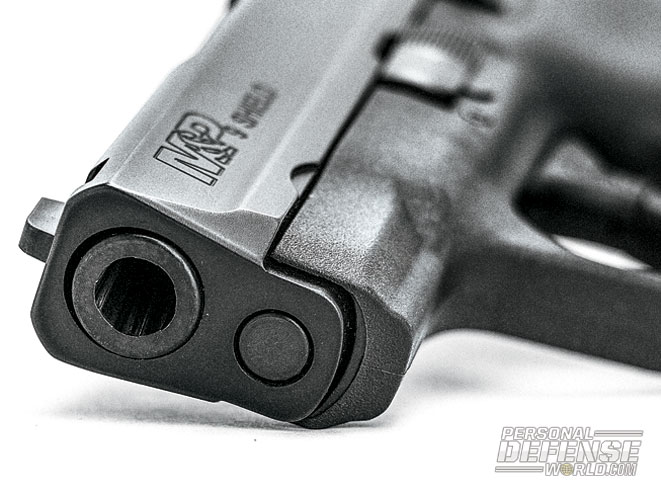
The M&P Shield is a thin gun. Measuring less than an inch thick, the gun is easy to conceal underneath a shirt or other garment. The gun is also small enough to be carried in an ankle holster as a law enforcement officer’s backup gun. Part of the reason the gun is so thin is because it is a single-stack pistol. The gun I had was chambered in 9mm, but .40 S&W is also available. Single-stack 9mm pistols have been gaining in popularity over the years, and many of the major manufacturers now offer one.
Advertisement — Continue Reading Below
RELATED: Smith & Wesson’s Model 686 Plus Revolver
The M&P Shield is not the first successful, compact, single-stack 9mm from Smith & Wesson. One of the more popular concealed carry pieces of the 1990s was the Smith & Wesson Model 3913. The Model 3913, still popular with many shooters today, is a hammer-fired, metal-framed pistol. Although a different gun entirely, I can’t help but think the Shield is a spiritual descendant of the venerable Model 3913.
As with many of Smith & Wesson’s current pistol offerings, the Shield is a striker-fired handgun with a polymer frame. The barrel is slightly longer than 3 inches, and the gun weighs only 19 ounces unloaded. Although the styling is consistent with the other pistols in the M&P line, the Shield does not have interchangeable backstraps like the larger guns. Because of the grip size, most people should not have any problems reaching the trigger.
Advertisement — Continue Reading Below
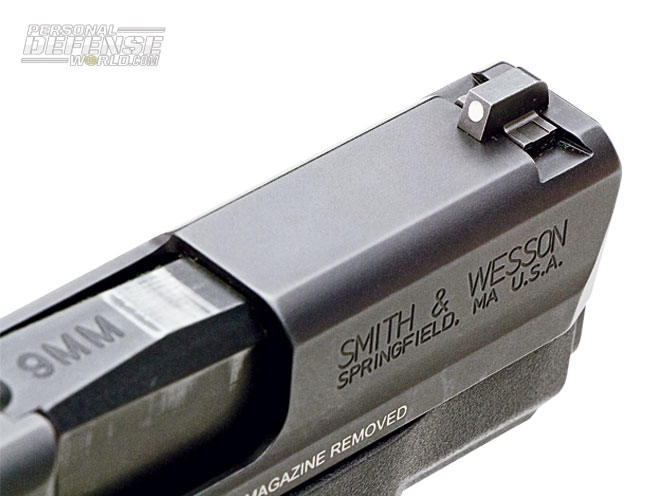
As with the original Shield, Smith & Wesson ships the pistol with a flush-fitting, seven-round magazine and an extended eight-round mag. The eight-round magazine has a sleeve that fits over a portion of the mag body and extends below the grip. This gives the shooter a little more gun to hold onto when shooting. However, the extension sleeve also can cause a problem by fouling magazine ejection from the gun. The sleeve is designed to act as a grip, it can hang on the hand when you press the magazine release. I have experienced this issue with other pistols that use a magazine sleeve similar to this one. The problem is less pronounced on the Shield than other guns, but it still exists.
RELATED: 5 Smith & Wesson Guns for Everyday CCW Self-Defense
Advertisement — Continue Reading Below
Several firearms instructors have told me they have seen the same problem with some of their students using the Shield in training classes. My recommendation is to train with the gun extensively before using it for self-defense. If the extended magazine ever gives you problems, consider using flush-fit magazines only. The good news is the gun will fit most people’s hands without the need for the extension. My hand fits on the grip without having to curl my pinkie underneath the gun.
Sights on the pistol are three-dot style, and are large enough to be seen and used easily. Both the front and rear are dovetailed, so you can add tritium or fiber-optic sights if you prefer. There are several companies making aftermarket sights designed to fit the M&P Shield. One of the benefits of the gun being part of an established line is that there is already a plethora of accessories in the market. Lasers, holsters and internal parts are all readily available from most of the usual accessory companies.
The M&P Shield without a thumb safety remains very affordable. Its MSRP is only $449, and I’ve seen them being offered at retail prices for less than $400. That will put these guns into the budget of nearly everyone looking for a reliable concealed carry handgun.
Advertisement — Continue Reading Below
On-Range Duty
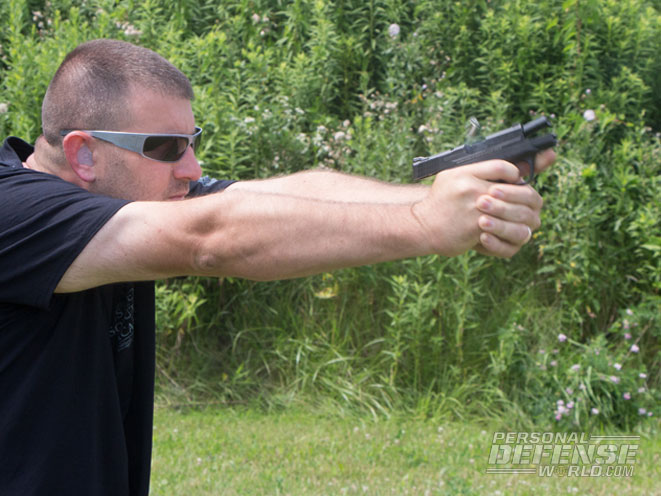
I was not surprised to find the Shield ran flawlessly on the range. Since the original gun was introduced more than two years ago, the technology is essentially debugged. I expected the gun to run well, and run well it did.
Advertisement — Continue Reading Below
RELATED: Gun Review – Smith & Wesson’s Semi-Custom M&P .40
With me at the range was a group of experienced shooters, police officers and firearms instructors. Among us, we put more than a dozen different kinds of ammunition through the gun, including standard-pressure, +P and +P+ loads. No matter what we fed it, the gun ate it up and asked for more.
One of the more interesting loads was from Liberty Ammunition. Liberty Ammunition offers a nickel-plated, solid-copper hollow point that is light and fast. At just 50 grains, the bullet has an exceptionally large, hollow point and averaged nearly 1,850 feet per second (fps) over my chronograph. Even with such a fast load, recoil felt the same or less when compared to any of the other defensive loads we shot.
Advertisement — Continue Reading Below
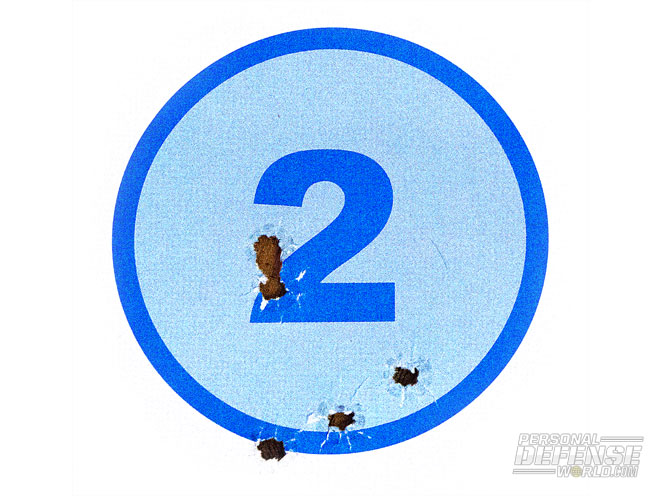
Some small guns have a harsh recoil impulse, but the Shield is not one of them. High-pressure loads were easy to manage. While recoil is greater on this gun than on a full-size M&P, follow-up shots were reasonably fast. The recoil spring is heavier than what I have felt on other compacts. Generally, good technique will overcome any problems with slide manipulation. There are some people, however, that will not be able to reliably operate the slide due to infirmity or other strength issues. Try working the slide in a gun store before laying down your dollars.
For a striker-fired pistol, the trigger felt heavier than I would have liked. Smith & Wesson rates the M&P Shield’s trigger pull at 6.5 pounds.
Advertisement — Continue Reading Below
Accuracy with this pistol was excellent. At 15 yards, groups were nearly as tight as they were at 7 yards. Hitting a man-sized target farther away, at 25 yards and beyond, should not be a problem for the average shooter.
Built For Backup
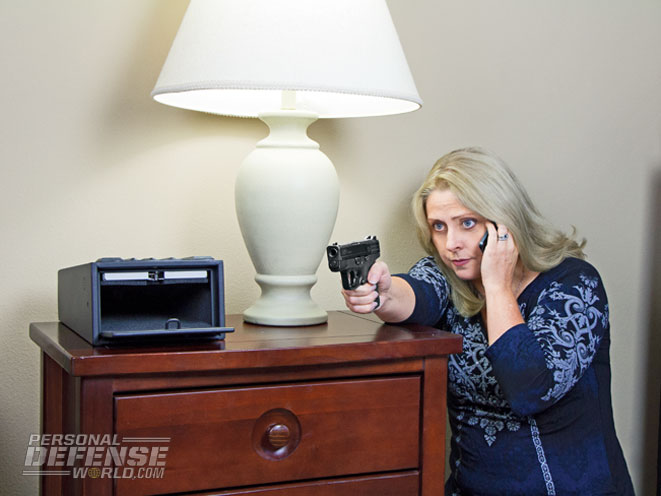
The pistols of the M&P Shield line are quality guns that are building a solid reputation for performance and reliability at an affordable price. They are made in the USA and are backed by a lifetime service policy from one of the biggest names in the industry.
I’d have no qualms about carrying one of these pistols for my own protection. My evaluation gun ran 100-percent reliably and was easy to shoot. If you are looking for a compact pistol in a duty caliber, I highly recommend checking out this new M&P Shield pistol from Smith & Wesson.
For More Information
Smith & Wesson
http://www.smith-wesson.com
Liberty Ammunition
http://www.libertyammunition.com
